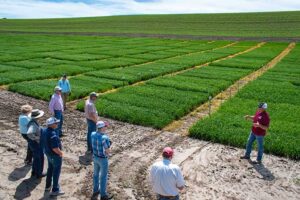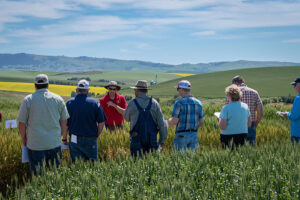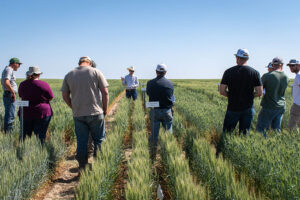In 2023, the Washington State University (WSU) Extension Cereal Variety Testing Program (VTP) saw yet another expansion of testing — this time to accommodate a new pipeline of winter wheat varieties carrying the Axigen trait (denoted with an “AX” after the variety name) for the CoAXium system. Many Washington growers are no doubt familiar by now with this new program for applying Aggressor herbicide postemergence on winter wheat. The VTP began testing CoAXium winter wheat varieties in earnest in 2023, with only a handful of WSU experimental lines tested in 2022. These varieties were separated from the common soft white winter wheat trials and combined with Clearfield varieties at each site to form their own trials. Below is a summary of their performance.

CoAXium winter wheat varieties
Limagrain has released a number of CoAXium varieties in just the past couple of years, some of which are already commercially available to growers. These include LCS Dagger AX, LCS Dragon AX, LCS Hydra AX, LCS Kraken AX, LCS Reaper AX, LCS Scorpion AX, LCS Eclipse AX (hard red winter), and LCS Helix AX (hard red winter). Based on 2023 data, LCS Scorpion AX had the best yield performance in the higher rainfall regions of all the soft white wheat Limagrain AX varieties. In the lower precipitation zones, LCS Kraken AX and LCS Scorpion AX tended to have better yield than other LCS CoAXium varieties.
In 2023, WSU released its first CoAXium soft white winter wheat variety, Nova AX (previously WA8346 AX). This variety is broadly adapted and is the number one “AX” line for yield in two out of four precipitation zones. LCS Kraken AX and Nova AX both have solid agronomic packages based on the current ratings available, which make them broadly adapted and even well suited for the Highway 2 corridor including Douglas County. LCS Kraken AX has a slight advantage over Nova AX for stripe rust, while Nova AX has a slight advantage over LCS Kraken AX for snow mold. While LCS Kraken AX is already widely available for growers, certified seed availability for Nova AX is still another year or two out.
For growers looking to grow a hard red winter CoAXium variety, LCS Eclipse AX showed about a 10-bushel-per-acre yield advantage over the other hard red winter AX variety, Battle AX, in the high rainfall areas. It also outperformed Battle AX and LCS Helix AX below 16 inches of precipitation, though Kivari AX, a Colorado State University variety marketed by PlainsGold, came out on top numerically and had one of the best test weights in the trial overall.

Clearfield winter wheat varieties
Sockeye CL+ had a banner year in 2023, taking the number one spot in every single dryland precipitation zone for yield, which was also true on the two-year average. Piranha CL+ was generally right there with it, coming in second in most cases. These sister lines from the WSU breeding program have very solid agronomic packages, allowing them to be grown in most production areas of Washington, though Sockeye CL+ has better stripe rust resistance compared to Piranha CL+. VI Encore CL+ is a new release from the joint Varsity Idaho
breeding program between University of Idaho and Limagrain. It generally came in above average for yield at most sites, but behind Sockeye CL+ and Piranha CL+.
While VI Encore CL+ has weaker ratings for emergence and aluminum tolerance, its good stripe rust resistance and stiff straw make it a possible option to blend with Sockeye CL+ or Piranha CL+ under high production situations due to their weaker straw. VI Voodoo CL+ performed the best in the 16-20-inch precipitation zone in 2023; however, growers are cautioned not to push this variety too far north as significant winter injury occurred in producer fields and variety trials in 2024.
Metribuzin-tolerant winter wheat varieties
For growers dealing with herbicide-resistant weedy grasses, a new variety released by WSU may provide another option for control. Rydrych MZ, previously named ARS Selbu 2.0 in the WSU variety trials, was identified as a superior variety in trials screening for metribuzin tolerance. Winter wheat varieties can vary on their tolerance to Metribuzin, and so growers applying this product on their wheat often use a lower rate to reduce the risk of injury to the crop. This variety allows growers to apply the highest labelled rate of Metribuzin without fear of crop injury. While yield potential is not as high for this variety as other soft white wheat varieties, it was released primarily to give growers another tool to clean up weedy fields.

Other new common winter wheat varieties
Two new soft white wheat varieties named in 2024 include AP Olympia (PN17MM604207) from AgriPro and Windust (WA8362) from WSU. AP Olympia generally landed two-to-three-bushels per acre above the trial average for yield. Available ratings are limited so far for this new variety, but early indications are that it has very good cold tolerance and stripe rust resistance. Windust was released specifically targeting low rainfall, deep furrow planting as it has superior emergence. It also posses strong cold tolerance, stripe rust resistance, and snow mold tolerance. Growers should note that this nonsemidwarf variety will give up some grain yield potential compared to other varieties to gain the excellent emergence.
In nearly every instance, LCS Missile came out on top compared to LCS Blackbird in the 2023 hard red winter variety trials. It also had a one-to-two-pound-per-bushel better test weight. Gemini (WA8310) was released by WSU in 2023 and appears best adapted to the 12-16-inch precipitation zone. Yield dipped slightly in 2023 after landing near the top of the trial for this zone in 2021 and 2022. Compared to Scorpio, Gemini tends to have better test weight and lower protein.
To view additional ratings and the full results from these trials, please visit smallgrains.wsu.edu/ variety/2023-variety-data/. When possible, always use multiple years and locations within a region to better gauge the adaptation and yield stability of a particular variety. And lastly, all WSU field days are listed on the WSU Small Grains Extension website, which is at
smallgrains.wsu.edu/variety/.
Acknowledgements: Funding for the WSU Extension Uniform Cereal Variety Testing Program is provided by the Washington Grain Commission. Variety trials are made possible by the contribution of land and time from farmer cooperators where the trials are located.
This article originally appeared in the May 2024 issue of Wheat Life Magazine.
The CoAXium Wheat Variety Trial Summary tables conducted by the WSU Extension are available in the original Wheat Life article via the provided link above, or you can access them directly from the WSU Wheat & Small Grains 2023 variety data.

Clark Neely
Extension Agronomist and Cereal Variety Testing Lead, Washington State University
